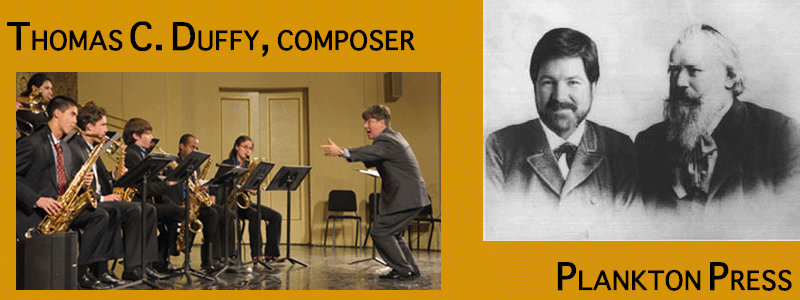Butterflies and Bees!
(1999) c. 10:00 (Wind Band)
Commissioned by the Bishop Ireton Symphonic Wind Ensemble Garwood Whaley, Director
Level: High School/College
Butterflies and Bees! is a tone poem based on the unique characteristics of and "differences" between the two insects. Butterflies are light, floating, pretty, delicate, gentle, colorful, calm, ethereal, shimmering insects that move among and around beautiful flowers, both in groups and individually: "Butterflies are certain diurnal insects with slender bodies and four broad, membranous wings covered with bright colored tiny scales." Within the butterfly species, the Monarch butterfly bears its regal name in tribute to its large size and broad wingspan.
Bees are industrious, busy, angry, dangerous, damaging, stinging, swarming little insects: "Bees are four-winged, hairy insects that live in swarms containing three classes: females or queen bees (of which there is only one in each swarm); males or drones; and neuters or worker bees." The functions of the bee classifications reflect some of the more brutal attributes of the species -the queen propagates the species with help of the drones, after which the drones are destroyed by the workers! The females and the workers have barbed stingers!
Certainly one can recognize the differences in the general character of these two insect groups, notwithstanding that some bees produce honey and are actually quite necessary in the pollination of flowers. This tone poem, based on these differences, opens with the gentle "sounds" of a country sunrise. A butterfly appears, then two, then three, then many. The cloud of butterflies passes (m. 23) and all that is left is the shimmer of their many-colored wings. A straggler (or is it a bee?) passes (m. 25), and then another "cloud" of insects appears, this time rising up from the ground. One insect after another takes wing (mm. 26-42), until the cloud is fully formed (m. 42-). These could be bees or butterflies – after all, they do share some common attributes (wings, royal figures [Monarchs and queens], flight, flapping). The insects' royal figure appears (m. 53) for an instant (low brass), only to be subsumed by the cloud. This cloud of insects passes off into the distance (m. 58) and fades away. Inside the hive, the worker bees are doing their duties (mm. 59-105); the drones are milling about waiting for the queen - this congregation is a mass of wings and stingers! The queen appears accompanied by a royal fanfare (mm. 80-83); drones and workers clash; the hive gradually calms down, with only a few industrious insects emitting any sounds (m. 104). But another wave of insects appears (mm. 105-123); bees or butterflies? The final "swarm" (mm. 124-155) is thick and active; perhaps one can hear both the flutter of butterfly wings and the buzz of high-speed, highly driven bees? In a flash (of thunder?), the swarm has passed, and the gentle echo of wing-beats fades into the distance.
Only two sections are specifically identified as being representative of butterflies (mm. 1-25) and bees (mm. 59-105). The conductor and/or musicians may decide which insects are represented elsewhere in the tone poem. The music is intended to support either interpretation. The tone poem is meant to serve as a kind of Escher portrait-in some places, one can assign to the same musical material either of the "opposing" programs (bees or butterflies). Thus, the same music can represent either bees or butterflies, just as the foreground of an Escher print might shift from birds to fish, depending on the viewer's prospective. There could/ should be audible differences in the musical realizations by "bee-oriented" musicians as opposed to "butterfly-oriented" musicians.
At the metaphysical level, this tone poem is an allegory for the unique characteristics of the left and right hemispheres of the brain, and/or the opposing apollonian and dionysian aesthetics.
| Conjunct, beautiful, impressionistic | Disjunct, aggressive,classical |
| Qualitative, patient | Quantitative, driven |
| Butterflies | Bees |
| Right hemisphere | Left Hemisphere |
| Dionysian | Apollonian |

